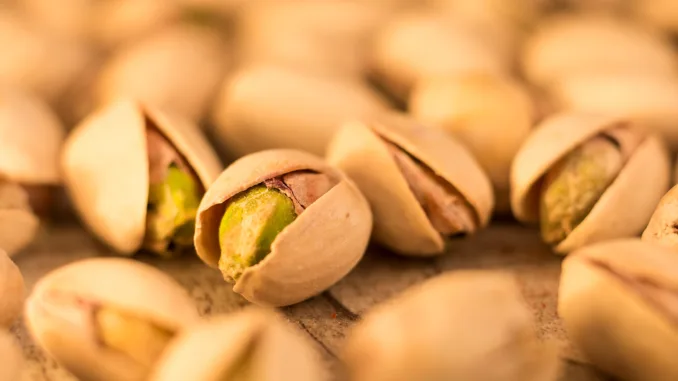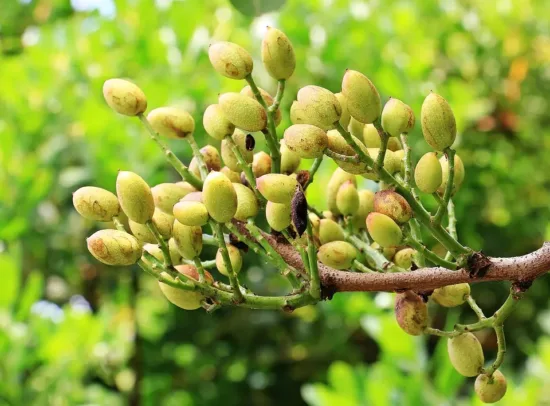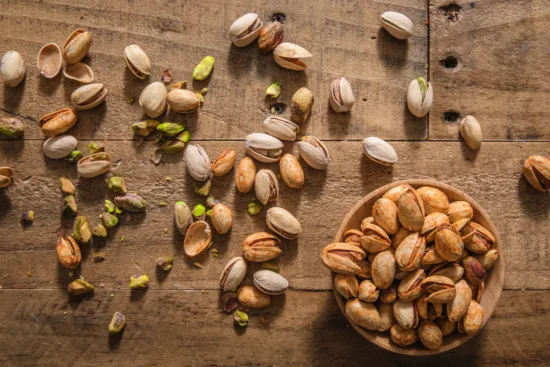
Pistachio has roots in Central Asia and the Middle East but is becoming a café favorite in the Western specialty-coffee world.
BY EMILY JOY MENESES
BARISTA MAGAZINE ONLINE
Cover photo courtesy of Theo Crazzolara via Unsplash
Odds are that you’ve had a hazelnut-flavored latte before—but have you ever tried a pistachio latte? With pistachio becoming increasingly popular as a syrup and alternative milk, we decided to make it the star of our latest installment of “Know Your Ingredients.“ Today, we’ll explore how it’s grown, some of the ways it’s being incorporated into café menus, and whether pistachio milk stands up to other dairy alternatives. Read on to learn more!
Growing Pistachios
Pistachios are commonly considered nuts—but, botanically, the pistachio is actually a seed. They grow on trees in grape-like clusters that can range in size from 30 to 50 nuts. The pistachio tree originated in Central Asia and the Middle East; archaeologists have found evidence of pistachios at dig sites near northeastern Iraq dating back as early as 6750 B.C.

The pistachio tree thrives in hot, dry climates. Today, most of the world’s production come from Afghanistan, Iran, Italy, Syria, and Turkey. Arizona, New Mexico, and California’s Central Valley—with their hot, dry climates and moderate winters — also offer ideal environments for pistachios to grow. These three states make up 100% of commercial production in the United States.
Travels: From East to West
In Persia (modern-day Iran), pistachios symbolized wealth and status. It’s believed that the Queen of Sheba adored them, demanding all of her land’s production to belong to her and her court. Pistachios were also prized in ancient Rome and Greece. They eventually made their way to Italy and Spain, spreading throughout the entirety of the Mediterranean. Traders and explorers would take the seeds on their travels, valuing them for their long storage life and nutritional value. They finally made their way to the Western world via the Silk Road, which bridged the East with the West.

Pistachio in Specialty Coffee
Today, we’re seeing the pistachio increasingly making itself known in the specialty-coffee world in the form of flavored lattes and pistachio milk. We love Intelligentsia Coffee’s pistachio rose latte, made with Taché’s pistachio milk, rose water, and orange syrup made in-house. The latte is topped with ground cardamom and rose petals—ingredients that allude to pistachio’s Middle Eastern roots. Monin also offers pistachio syrup, which adds a touch of nuttiness and “rich, roasted pistachio flavor” to any beverage.
A Dairy Alternative
When using pistachio milk at home or at your café, there are a few factors to consider: taste, texture, cost, and sustainability. When it comes to flavor, pistachio has a nutty flavor: Unlike almond milk’s more neutral taste, pistachio milk retains a lot of the pistachio flavor that you get when eating raw nuts. We’ve also found that pistachio milk froths up quite nicely, with a texture similar to that of oat milk.

When considering cost, pistachio milk is one of the priciest dairy alternatives, though one plus is that it has a long shelf life. In terms of sustainability, the milk is a lot more environmentally friendly than almond milk. Growing pistachios requires about half the amount of water that’s used to grow almonds, making pistachio milk similar to oat milk in terms of eco-consciousness.
An Established Future
Though pistachio is still a relatively new addition to the specialty-coffee world’s rotation of ingredients, its increasing popularity shows that it’s here to stay. Give it a try and discover why pistachio has been so highly sought after for thousands of years.
ABOUT THE AUTHOR
Emily Joy Meneses (she/they) is a writer and musician based in Los Angeles, California. Her hobbies include foraging, cortados, vintage synths, and connecting with her Filipino roots through music, art, food, and beverage.

